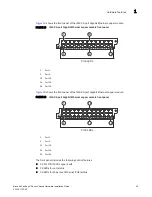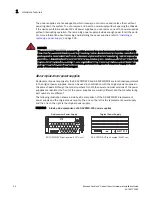
Brocade FastIron X Series Chassis Hardware Installation Guide
37
53-1001723-02
Hardware features
1
About redundant power supplies and power supply failure
A
FastIron
chassis with redundant power supplies can maintain full operation when one or more
power supplies fail. Power supply failure can be a failure of the supply itself or the office power grid
connected to the power supply.
A
FastIron
chassis can be either 1 + 1 redundant or N + 1 redundant.
1 + 1 redundancy
implies
that for every power supply, there is another redundant (backup) power supply. In other words, half
of the supplies in the system can fail, and the system will still operate normally.
N + 1 redundancy
implies that there is one redundant power supply for N power supplies, where N is a number
greater than one. For example, 3 + 1 redundancy means that in a system with four power supplies,
the system will continue to operate normally if one power supply fails, but will not operate if more
than one power supplies fail.
Power consumption is equally distributed (within a certain percentage depending on power load or
power supply type) among all power supplies in the system. When a power supply fails, the power
load is redistributed equally among the remaining power supplies. Note that power consumption
between POE and System power supplies is not shared, meaning loss of a System power supply
does not impact a POE power supply, and vice versa.
What happens when one or more system power supplies fail
If one or more System power supplies fail and the system is left with less than the minimum
number of power supplies required for normal operation, the power supplies will go into overload
and the system will start to shut down. Several things can happen. The output voltage of the
remaining good power supplies will likely drop as they try unsuccessfully to generate more power
than they are capable of. The system will react to a drop in voltage by increasing the current draw.
The hardware will shut down due to over-current protection or under-voltage protection, whichever
takes place first. One by one, the interface modules will shut down until the power is within the
power budget of the remaining power supplies. There is no particular order in which the interface
modules will shut down, as this will occur in hardware and not in software. The management CPU
requires power as well, and may also shut down during a power supply failure.
After a power loss, if the system is left with less than the minimum number of power supplies
required for normal operation, the system will be left in an unknown state. At this point, manual
recovery is required (i.e. restore power and power cycle the chassis).
What happens when one or more POE power supplies fail
If one or more POE power supplies fail and the system is left with less than the minimum number of
POE power supplies, the POE power supplies will go into overload. Non-POE functions will not be
impacted, provided the System power supplies are still up and running. Several things can happen
with a POE power supply failure. The output voltage of the remaining good power supplies will likely
drop as they try unsuccessfully to generate more power than they are capable of. The system will
react to a drop in voltage by increasing the current draw. The hardware will shut down POE function
due to over-current protection or under-voltage protection, whichever occurs first. The interface
modules will start to shut down its POE ports one by one until the over-power is within the power
budget of the remaining power supplies. There is no particular order in which the POE ports will
shut down, as this occurs in hardware and not in software.
After a power loss, if the system is left with less than the minimum number of power supplies
required for normal operation, the system will be left in an unknown state. At this point, manual
recovery is required (i.e. restore power and power cycle the chassis).
















































